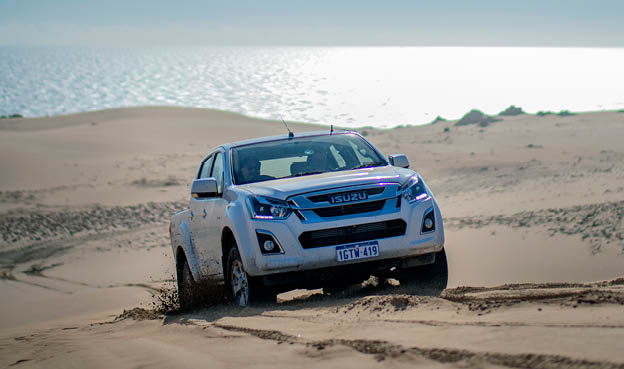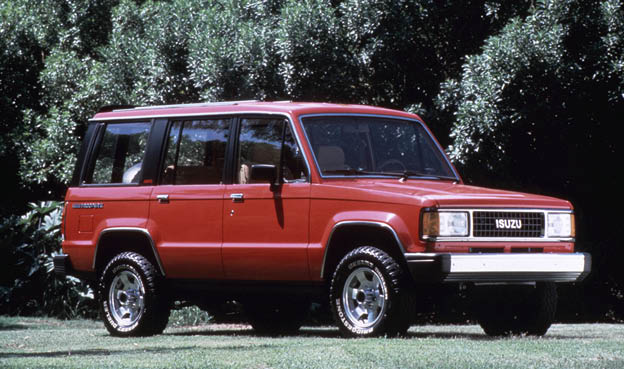

Ours is the sunburnt country and for bloody good reason: we have the lion's share of the world's greatest beaches. We also have some of the world's best 4wd beaches. Australia's coastal and island adventures range from chilled cruising to dune-based adrenaline thrills.
Note: Tackle these trips in a 4WD with low-range gearing (or the equivalent) and high ground clearance. Always organise vehicle access and camping permits, if applicable, prior to your trip.

FRASER ISLAND (K'gari), GREAT SANDY NATIONAL PARK, QLD
The world's largest sand island is about 300km north of Brisbane and 15km off the coast of Hervey Bay. At 123km long, the World Heritage-listed island is almost two and a half times the size of Tonga.
The go-to sandy drive here is 75 mile Beach on the island's east coast. Imagine driving along a pristine, open beach under a brilliantly blue sky and warm sun, with the cool breeze from a startlingly clear ocean as a welcome companion. Now, dump that mental image because the reality is much better.
It's a cinch in favourable conditions; the sand can be nice and firm, making for a (sensibly) fast drive—80km/h is the speed limit. But the thrills here lie in unpredictability. Rain and big seas can result in deep washouts, exposed rocks, washed-up logs and eroded dunes. The pay-off is Fraser's myriad scenic delights, such as the Champagne Pools, Indian Head, the Maheno wreck, freshwater Eli Creek and 40 or so freshwater lakes.
Get there: Via a 10-minute vehicle barge from Inskip Point (near Rainbow Beach) to Hook Point on Fraser; no bookings required. Or the 30-minute barge from River Heads (north-east of Maryborough) to Kingfisher Bay and Wanggoolba Creek; bookings required. The 75 mile Beach track starts 20km from the Hook Point drop-off. Visit fraserislandbarges.com.au for barge departure times.
Pro-tip: Fraser's beaches and sandy inland roads are suitable only for highclearance 4WDs preferably with lowrange capacity. Drive two hours either side of low tide; avoid driving two hours either side of high tide. Beware dingoes, backpackers in hired troop carriers and— alarmingly—planes. Authorised aircraft have designated, signposted landing zones on the eastern beach. Check island conditions at nprsr.qld.gov.au when planning your trip.

RAINBOW BEACH, COOLOOLA RECREATION AREA, QLD
Just 240km north of Brisbane, Rainbow Beach is virtually next door to Fraser Island but on the mainland.
Teewah Beach, in the Cooloola Recreation Area, is 40km of open beach leading to Rainbow Beach, via Double Island Point, which boasts coloured sands, stunning coastline … and the notorious 4WD-gobbling natural obstacle known as Mudlo Rocks.
Mudlo, a tricky little section south of Rainbow Beach township, has claimed many vehicular victims, especially those driving from Double Island Point. It's a rather innocuous-looking arrangement of rocks but it turns nasty with the high tide. Recently, it's been made even worse, with rocks further exposed by erosion. Tackle Mudlo in rising waters at your peril.
Get there: Beach access is from Rainbow Beach. From Tewantin, take the Noosa River ferry to Noosa North Shore, then go north along Teewah Beach to Freshwater, Double Island Point and Rainbow Beach.
Pro-tip: Beware the tide, but it can also provide entertainment when combined with idiots. Set up your camp chair at Mudlo Rocks and watch the carnage.
STOCKTON BEACH, NSW
About 220km north of Sydney, Stockton Beach is part of the Worimi Conservation Lands (WCL) and is NSW's longest beach. It stretches 32km from Birubi Point to the mouth of the Hunter River at Newcastle.
Beach driving here is hugely popular. Stockton's steep, shifting ‘sand skyscrapers', some 30m high, are said to be part of the Southern Hemisphere's largest continuous mobile coastal sand mass. There's plenty to do—including surfing, beach fishing, whale watching and exploring Aboriginal cultural sites (camp sites, middens and more)—but the beach driving is epic. Visitors are allowed to drive on the beachfront and in the designated Recreational Vehicle Area.
Get there: Enter the WCL via Lavis Lane at Williamtown (at the southern end of Stockton, about 25km from Newcastle) or via Gan Gan Road at Anna Bay. Call the Hunter Region NPWS office on 02 4984 8200 for beach vehicle permits.
Pro-tip: Conditions can change swiftly. In the past, waves have swamped the beachfront, even at low tide, and deep pools of water have accumulated at the beach entrances, creating large areas of very soft sand. Look out after huge swells and tides that can erode the beach, causing hazardous driving conditions: drop-offs, flooding or impassable sections. Several people have been killed in accidents on Stockton. Take care.

CABLE BEACH, BROOME, WA
In the Kimberley, 2,200km from Perth and 1,860km from Darwin, is a 22km stretch of white sand; Indian Ocean on one side, red dirt and cliffs on the other. In the company of some of the hard-charging beach drives listed here, Cable Beach offers a distinct change of pace. The tidal range means the beach can be 200m wide at low tide, making for an easy and relaxing drive; at high tide, it's still about 30m. It's not Australia's most thrilling beach drive, but it's certainly one of the most beautiful—and most chilled out.
Get there: The vehicle access ramp is near the sealed car park, off Cable Beach Road, about 6km from Broome. Simple.
Pro-tip: Beware the motley trifecta of backpackers, camels (often lumping backpackers) and nudists. Some people still insist on getting their gear off at Cable's northern end. Beware sunburn.
COFFIN BAY, EYRE PENINSULA, SA
Coffin Bay National Park is 50km west of Port Lincoln, in the heart of Dean Lukin, abalone and great white shark country.
The bay's fantastic northern beaches are accessible only by high-clearance 4WDs. Beach access is easy enough, but the beach itself can be difficult to tackle. The deceptively soft and/or deep sand, tricky dunes and jagged, exposed rocks make it an awesome destination for keen four-wheel drivers. Legendary off-road adventurer and publisher Ron Moon has praised Coffin Bay for its beauty and its challenges. As well as off-roading, there's great beach fishing, bushwalking, birdwatching, surfing and more.
Get there: Via Coffin Bay Road from Flinders Highway. Call 08 8688 3111 or visit parks.sa.gov.au to sort out permits.
Pro-tip: National Parks SA officials warn visitors to expect "varying road conditions along beaches, with sandy, boggy and rocky patches". Look out for huge surf (some of the breaks here are for experienced surfers only) and—we're not kidding—feral bees. They're attracted to water sources in the park.

OCEAN BEACH, TAS
About 300km west of Hobart, Ocean Beach is Tassie's longest beach (about 40km), stretching from the ominously named Hell's Gates in the south to Trial Harbour in the north. Drive it and you have the Great Southern Ocean at one shoulder—replete with shore-smashing breakers and tricky tides—and the Wild, Wild West coast at your other.
There are two major water crossings—through Henty and Little Henty rivers—along the beach route. The degree of difficulty can vary from ‘Easy' (when both river mouths are blocked by sandbars) to ‘Don't Like Your Chances' (when the rivers are fast flowing into the ocean).
Get there: Access is via Ocean Beach Road at Strahan.
Pro-tip: Severe weather can wreak havoc, with talk of quicksand-style surfaces at the mouth of the enty River. There are also strong rips, so avoid swimming. As always, work around the tides. Do remember to stop and have a good bellow at the sand. Ocean Beach was formerly known as Great Roaring Beach. Reason enough to visit it, then.
ROBE TO BEACHPORT, SA
Disappointingly, dressing gowns are not de rigueur in Robe—but the crayfish make up for it. The town is about 340km south-east of Adelaide, and the run from Robe to Beachport is 58.5km.
This trip has been a real four-wheel drivers' favourite for a long time. Very soft sand, track closures along the windswept route and high tides that swamp the beach all add to the adventure. Escape tracks along the way help drivers avoid any strife as a result of incoming tides.
According to respected 4WD journalist Allan Whiting, who visited last March, "The track weaves from beachfront to inland routes as it skirts small bays and headlands. At high tides there are several points that require inland detours and there are some very steep climbs as well."
It was once possible to drive the length of the beach from Robe to Beachport, but it's now necessary to detour between Stinky Bay and Little Dip Conservation Park. A short private track across the Nora Creina property cuts travel time.
Get there: Access is about 4.5km north of Beachport or just south of Robe.
Pro-tip: When taking the Nora Creina short cut, respect the owners' property (their cabins and surroundings): Drive carefully, stay on the marked track and leave the gates as you find them.





